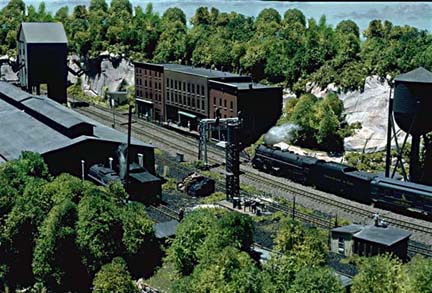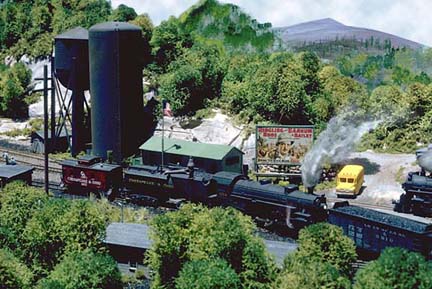|
By Paul Fulks
The "Thurmond", West Virginia which has appeared at several N.M.R.A. Conventions and in various model railroad magazines was built in 1991 following four years of taking pictures, measuring buildings and studying the prototype, which is now nearly gone.
Actually the real Thurmond began in an eventful year of 1871, the same year Mrs. O'Leary's cow set fire to Chicago and Collis P. Huntington founded the town of Huntington, West Virginia, my hometown.
Thurmond was built on a 73-acre tract of ground that was acquired by William Dabney Thurmond a short time after the civil war. The tract of land was in payment for surveying work done by Mr. Thurmond for John Bowyers a local landowner. At this particular time the C&O railroad that would link Newport News and the Ohio River was not yet completed, however it was under construction and in the year 1873 the final connection was made near Hawks Nest, West Virginia
Mr. Thurmond was aware of the coal deposits across the river from Thurmond, up Dunlop Creek and downstream at Arbuckle Creek. The first coal in the New River Gorge was mined and shipped out of Quinnemont, which is a few short miles up stream from Thurmond. This coal production was the beginning of nearly 70 years of commerce in this area. The town of  Thurmond became a marshalling yard to run coal both east and west out of the town and at one time in its infancy it was claimed that freight tonnage shipped out of Thurmond more than doubled the combined shipments of Richmond and Cincinnati. Thurmond became a marshalling yard to run coal both east and west out of the town and at one time in its infancy it was claimed that freight tonnage shipped out of Thurmond more than doubled the combined shipments of Richmond and Cincinnati.
The town of Thurmond really boomed after a wealthy entrepreneur from Chillocothe, Ohio by the name of Thomas G. McKell acquired land holdings from his wife's father as a marriage gift. His father-in-law just happened to be a part of the Dunn and Bradstreet group from the east. After building his famous hotel across the river from Thurmond called the Dunglen, he convinced the railroad to construct a bridge which connected the north side of New River with the south side and the coal deposits of Dunlop and Arbuckle creeks. The year was 1889 and the economy burst at the seams as "high rollers" from the east began frequenting the Dunglen Hotel to make deals, gamble, frolic and drink. This continued until prohibition and the construction of a pa ved road down the hill from Glen Jean in 1917. Until that time the only way into the gorge was by rail from east or west. ved road down the hill from Glen Jean in 1917. Until that time the only way into the gorge was by rail from east or west.
There was never any coal mined in Thurmond as it was mainly a service facility for the railroad which brought more than 500 people to its population in its hey day. The citizens required the services of merchants, bankers, lawyers, doctors and various other occupations.
Today , Thurmond has a population of 5 (at least at last count) and the only remaining remnants of this once proud community are the coal dock, three derelict brick and stone structures, the commissary building and a recently refurbished depot which is owned and operated by the Park Service. Future plans to rebuild parts of the town for tourism are on hold . |